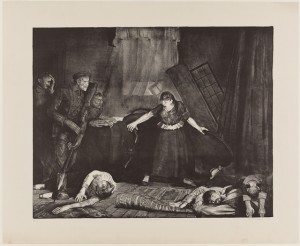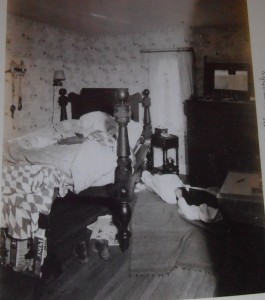The relationship between humans and their objects is quite interesting, especially when trying to determine what type of person someone was solely from the physical items surrounding them. A lot can be told about a person’s death as well as the life that he or she may have led. In murder scene archaeology, often times the victim was caught off-guard and was surprised by the attack. Even through art (photographs as well as paintings) we can see many different aspects of a person’s death, life, and what kind of person they were without even knowing their name.

In a George Bellows painting, a crime scene is depicted. Three German soldiers are shown invading a Belgian home. This took place right after World War I. An interesting thing to take note of is the fact that throughout the years, war conflict has become more and more anonymous. During World War I, the soldiers could see their victims come to terms with the fact that their lives were going to be taken from them. However, as the concept of dehumanizing the enemy became more and more imperative throughout warfare, now people may not even see it coming. They may not ever know who killed them. In this Bellows painting, a woman sees the three German soldiers and her dead family members (most likely). She clutches a chair and a table as she recognizes her fate. She knows that she will most likely end up as the people on the floor had. In most George Bellows paintings, there is a sense of impending doom or approaching danger.
In another crime scene piece of art (this time a photograph), the photographer, as well as the victim, remains anonymous. Without knowing anything about this person lying dead on the floor, an archaeologist can use objects in his room in order to understand the life that this man has led. We know that this took place in mid-March, 1946 because of the issues of Post magazine lying on the ground. We also know that the certificate on the dresser was a recent accomplishment. There is also a pistol and a flask hanging somewhere in the room, showing lack of use for them but lingering affection for these objects. The clear ashtray shows that the pipe was not being used; perhaps it was a gift to the victim. We can tell that this young man was religious because of the Bible and rosary beads in his room. We know that the victim may have enjoyed the comics section of the newspaper, as it was open to that section while lying under the bed.
These pieces of artwork show that archaeologists do not necessarily need to be in the room of the crime scene or even know anything about the victims in order to learn something about the types of people they were and the lives that they led. These crime scenes make us think about our lives in general and how we will be remembered. It raises certain questions about our lives and memory after we are gone. Will our deaths be recorded? Will we be analyzed by archaeologists in the future? What will be remembered of us after we are gone?
Links to Images:
http://museums.fivecolleges.edu/info.php?museum=ac&v=1&s=Bellows&type=all&t=objects&f=&d=&page=1
http://pages.vassar.edu/realarchaeology/files/2013/11/PB020018-265×300.jpg

